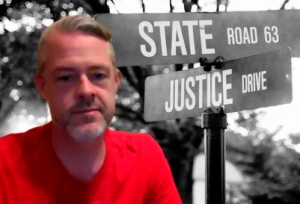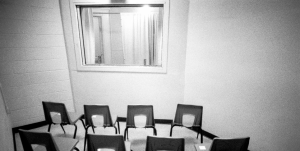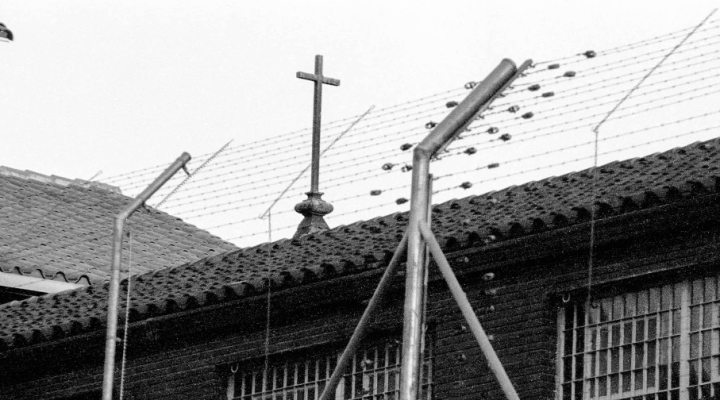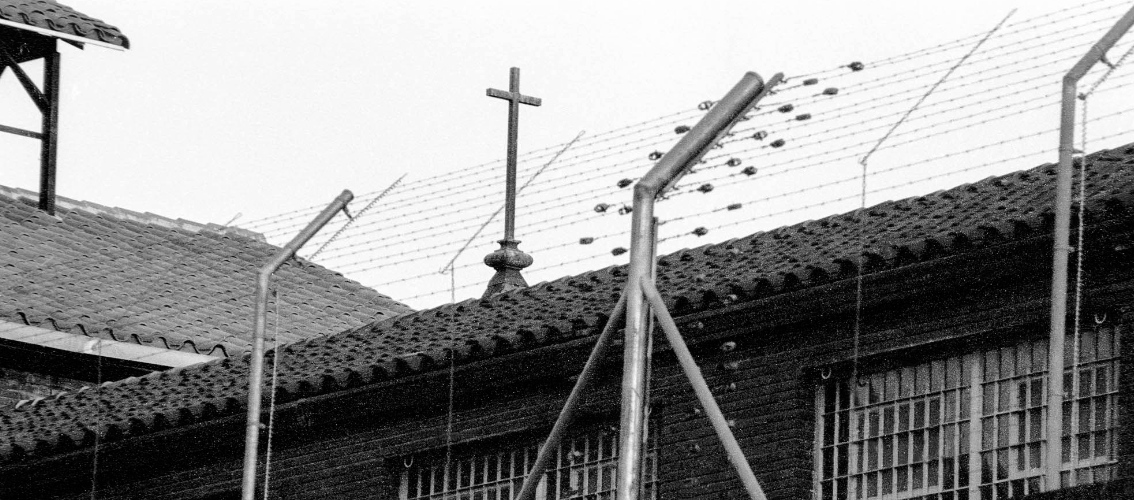Activist and photographer Scott Langley said the direction of his life and ministry changed the moment he spotted and photographed a large Cross atop the state death chamber in Huntsville, Texas, in 1999.
Langley was present on an execution day as part of a history project at Southern Methodist University in Dallas, where he was majoring in sociology. “There were 98 executions that year and half of them were in Texas,” he said during a Nov. 30 webinar hosted by the EJUSA Evangelical Network and moderated by network manager Sam Heath.

Scott Langley
The black-and-white image that resulted from the photo shoot has been hailed by death penalty abolitionists as symbolic of the tragedy and pain of state-sanctioned executions. But it also transformed Langley’s personal views about capital punishment, right then and there.
“When I looked up and saw the Cross and took that photo, for the first time the death penalty became real to me,” he said. “It wasn’t just something I was learning about in class. It wasn’t an abstract thing. It wasn’t just a headline in the newspaper in Texas the next day.”
Transformed, Langley launched into a calling to social justice ministry that has included death penalty opposition, civil disobedience and co-founding Death Penalty Action, which provides leadership, education and other support to the wider anti-death penalty movement.
He also used his original Cross photo to launch The Death Penalty Photography Project, a physical and online repository of images that includes an hour-by-hour execution timeline, portraits of executed and exonerated death row inmates and a death house video tour.
The project’s goal is to convince Americans about the barbarity of the death penalty.
The project’s goal is to convince Americans about the barbarity of the death penalty by providing them, through photography, with a greater degree of proximity to executions, Langley said.
“Not everyone is going to be standing outside a prison during an execution. So, it’s my hope that my photos can start to give a glimpse to people and enable them to experience what I’m experiencing so they will be transformed in the same way that I was,” he explained.

Last meal table (Photo by Scott Langley)
Before taking the image of the Cross in Huntsville, Langley said he was active in his faith and supportive of human rights causes but did not include capital punishment among his concerns. Being present for a Texas execution, however, changed that.
“It just became clear how wrong the death penalty was because it was no longer this abstract issue. It was realizing that we’re talking about a real human life,” he said.
While the photographic documentation of capital punishment and other forms of activism were to come for Langley, he described the immediate feeling as one of intense powerlessness.
“I felt in my heart, for the first time, how wrong this was and how much this was an affront to my faith, to human rights and to everything I believed.”
“In that moment I felt helpless. I wasn’t going to cross the police tape. I wasn’t going to charge those doors and somehow get inside that prison. But I felt in my heart, for the first time, how wrong this was and how much this was an affront to my faith, to human rights and to everything I believed.”
Langley said he continues to feel those emotions — sometimes so much that he must put down his camera. “Often, I’ll find myself in a situation where it’s inappropriate to take a particular photo, or sometimes I’m in a situation where I’m crying so much I can’t even take a photo. I can’t bring myself to see through the tears in these moments.”

Family grieving outside an execution site (Photo by Scott Langley)
In many cases, it is the family members of murder victims who provide the emotional strength to continue in the movement, he said. “I have role models, people who have been in those horrible places of having lost their loved ones and here they are, still advocating for rehabilitation and even sometimes for release of the perpetrator.”
Jesus also is an example, Langley added. “I can’t imagine Jesus ever supporting the death penalty in any way. When you say, ‘those without sin cast the first stone,’ it’s kind of that call to say we’re all sinners, so none of us can cast that first stone.”

Death viewing room (Photo by Scott Langley)
But changing minds isn’t easy in the U.S., which is the only Western nation to have the death penalty, he said. “Our country has this legacy of violence. We have a legacy of demonizing the other. We have a legacy of oppressing people of color. It’s a legacy we’re working to overcome.”
Heath said the American death penalty system is driven by fear. “It’s a fear of loss of control and safety in our country. And our criminal legal system says this (capital punishment) is the only option, that we have to confine and to execute and that’s absolutely untrue.”
Related articles:
The death penalty is dying a slow death; it’s time we pull the plug | Analysis by Stephen Reeves
Panel of faith leaders will raise awareness of death penalty injustice


